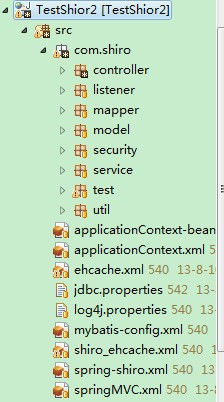Shiro详细配置-基于Spring3.2 shiro2.2
2013-08-16 15:09
369 查看

web.xml关键配置
<context-param>
<param-name>contextConfigLocation</param-name>
<param-value>
/WEB-INF/classes/applicationContext.xml
/WEB-INF/classes/spring-shiro.xml
</param-value>
</context-param>
spring-shiro.xml
<?xml version="1.0" encoding="UTF-8"?>
<beans xmlns="http://www.springframework.org/schema/beans"
xmlns:xsi="http://www.w3.org/2001/XMLSchema-instance" xmlns:util="http://www.springframework.org/schema/util"
xmlns:aop="http://www.springframework.org/schema/aop"
xsi:schemaLocation="http://www.springframework.org/schema/beans
http://www.springframework.org/schema/beans/spring-beans-3.0.xsd
http://www.springframework.org/schema/util
http://www.springframework.org/schema/util/spring-util-3.0.xsd">
<description>Shiro 配置</description>
<bean id="shiroFilter" class="org.apache.shiro.spring.web.ShiroFilterFactoryBean">
<property name="securityManager" ref="securityManager" />
<property name="loginUrl" value="/login.jsp" />
<property name="successUrl" value="/login.jsp" />
<property name="unauthorizedUrl" value="/error/noperms.jsp" />
<property name="filterChainDefinitions">
<value>
/login.jsp* = anon
/login.do* = anon
/index.jsp*= anon
/error/noperms.jsp*= anon
/*.jsp* = authc
/*.do* = authc
</value>
</property>
</bean>
<bean id="monitorRealm" class="com.shiro.security.MonitorRealm">
<property name="credentialsMatcher">
<bean class="org.apache.shiro.authc.credential.HashedCredentialsMatcher">
<property name="hashAlgorithmName" value="MD5"/>
<!-- true means hex encoded, false means base64 encoded -->
<property name="storedCredentialsHexEncoded" value="true"/>
<!-- 迭代次数 -->
<property name="hashIterations" value="2" />
</bean>
</property>
</bean>
<bean id="securityManager" class="org.apache.shiro.web.mgt.DefaultWebSecurityManager">
<!-- 基于ehCache来缓存用户认证信息和授权信息的实现 -->
<property name="cacheManager" ref="cacheManager"/>
<!-- sessionMode参数设置为native时,那么shrio就将用户的基本认证信息保存到缺省名称为shiro-activeSessionCache 的Cache中 -->
<property name="sessionMode" value="native" />
<!--设置自定义realm -->
<property name="realm" ref="monitorRealm" />
</bean>
<bean id="cacheManager" class="org.apache.shiro.cache.ehcache.EhCacheManager">
<property name="cacheManager" ref="ehCacheManager"/>
<property name="cacheManagerConfigFile" value="classpath:shiro_ehcache.xml"/>
</bean>
<bean id="ehCacheManager" class="org.springframework.cache.ehcache.EhCacheManagerFactoryBean"/>
<!-- securityManager -->
<bean class="org.springframework.beans.factory.config.MethodInvokingFactoryBean">
<property name="staticMethod" value="org.apache.shiro.SecurityUtils.setSecurityManager" />
<property name="arguments" ref="securityManager" />
</bean>
<!-- 保证实现了Shiro内部lifecycle函数的bean执行 -->
<bean id="lifecycleBeanPostProcessor" class="org.apache.shiro.spring.LifecycleBeanPostProcessor" />
<!-- AOP式方法级权限检查 -->
<bean
class="org.springframework.aop.framework.autoproxy.DefaultAdvisorAutoProxyCreator"
depends-on="lifecycleBeanPostProcessor" />
<bean
class="org.apache.shiro.spring.security.interceptor.AuthorizationAttributeSourceAdvisor">
<property name="securityManager" ref="securityManager" />
</bean>
</beans>
MonitorRealm.java
package com.shiro.security;
import java.util.ArrayList;
import java.util.List;
import org.apache.shiro.authc.AccountException;
import org.apache.shiro.authc.AuthenticationException;
import org.apache.shiro.authc.AuthenticationInfo;
import org.apache.shiro.authc.AuthenticationToken;
import org.apache.shiro.authc.SimpleAuthenticationInfo;
import org.apache.shiro.authc.UnknownAccountException;
import org.apache.shiro.authc.UsernamePasswordToken;
import org.apache.shiro.authz.AuthorizationInfo;
import org.apache.shiro.authz.SimpleAuthorizationInfo;
import org.apache.shiro.cache.Cache;
import org.apache.shiro.realm.AuthorizingRealm;
import org.apache.shiro.subject.PrincipalCollection;
import org.apache.shiro.subject.SimplePrincipalCollection;
import org.apache.shiro.util.ByteSource;
import org.springframework.beans.factory.annotation.Autowired;
import com.shiro.mapper.RoleMapper;
import com.shiro.mapper.UserMapper;
import com.shiro.model.Resc;
import com.shiro.model.Role;
public class MonitorRealm extends AuthorizingRealm {
@Autowired
private UserMapper userMapper;
@Autowired
private RoleMapper roleMapper;
public MonitorRealm() {
super();
setAuthenticationTokenClass(UsernamePasswordToken.class);
System.out.println("monitorRealm");
}
/**
* 验证
*/
@Override
protected AuthenticationInfo doGetAuthenticationInfo(AuthenticationToken authcToken) throws AuthenticationException {
System.out.println("monitorRealm-验证");
/* 这里编写认证代码 */
UsernamePasswordToken token = (UsernamePasswordToken) authcToken;
String username = token.getUsername();
if (username == null) {
throw new AccountException("Null usernames are not allowed by this realm.");
}
String password = userMapper.getPassword(username).getPassword();
if (password == null) {
throw new UnknownAccountException("No account found for user [" + username + "]");
}
SimpleAuthenticationInfo saInfo = new SimpleAuthenticationInfo(username, password, getName());
//用用户名填盐
saInfo.setCredentialsSalt(ByteSource.Util.bytes(username));
return saInfo;
}
/**
* 授权
*/
@Override
protected AuthorizationInfo doGetAuthorizationInfo(PrincipalCollection principals) {
System.out.println("monitorRealm-授权");
String username = (String) principals.fromRealm( getName() ).iterator().next();
// System.out.println(username);
if( username != null ){
SimpleAuthorizationInfo info = new SimpleAuthorizationInfo();
info.addRole(username);
info.addStringPermissions( this.Topermissions( userMapper.selectUserRole(username).getRoles()) );
// for(String str : this.Topermissions( userMapper.selectUserRole(username).getRoles()) ){
// System.out.println(str );
// }
return info;
}
return null;
}
/**
* 遍历角
af2e
色得到资源
*/
public List<String> Topermissions(List<Role> roles ){
List<String> permissions= new ArrayList<String>();
for( Role role : roles ){
permissions.addAll( this.ToResc( roleMapper.selectRoleResc(role.getRoleId()).getRescs() ) );
}
return permissions;
}
/**
* 遍历某个角色的资源
*/
public List<String > ToResc( List<Resc> rescs ){
List<String > resStrings = new ArrayList<String>();
for ( Resc resc :rescs ){
resStrings.add(resc.getResString());
}
return resStrings;
}
/**
* 更新用户授权信息缓存.
*/
public void clearCachedAuthorizationInfo(String principal) {
SimplePrincipalCollection principals = new SimplePrincipalCollection(principal, getName());
clearCachedAuthorizationInfo(principals);
}
/**
* 清除所有用户授权信息缓存.
*/
public void clearAllCachedAuthorizationInfo() {
Cache<Object, AuthorizationInfo> cache = getAuthorizationCache();
if (cache != null) {
for (Object key : cache.keys()) {
cache.remove(key);
}
}
}
public UserMapper getUserMapper() {
return userMapper;
}
public void setUserMapper(UserMapper userMapper) {
this.userMapper = userMapper;
}
public RoleMapper getRoleMapper() {
return roleMapper;
}
public void setRoleMapper(RoleMapper roleMapper) {
this.roleMapper = roleMapper;
}
}
UserController.java
package com.shiro.controller;
import org.apache.shiro.SecurityUtils;
import org.apache.shiro.authc.AuthenticationException;
import org.apache.shiro.authc.ExcessiveAttemptsException;
import org.apache.shiro.authc.IncorrectCredentialsException;
import org.apache.shiro.authc.LockedAccountException;
import org.apache.shiro.authc.UnknownAccountException;
import org.apache.shiro.authc.UsernamePasswordToken;
import org.apache.shiro.crypto.hash.Md5Hash;
import org.apache.shiro.subject.Subject;
import org.springframework.beans.factory.annotation.Autowired;
import org.springframework.stereotype.Controller;
import org.springframework.web.bind.annotation.RequestMapping;
import org.springframework.web.servlet.ModelAndView;
import org.springframework.web.servlet.mvc.multiaction.MultiActionController;
import com.shiro.model.User;
import com.shiro.service.UserService;
@Controller
@RequestMapping("/user")
public class UserController extends MultiActionController {
@Autowired
private UserService userService;
@RequestMapping("/login")
public ModelAndView login( User user ) {
ModelAndView mv = new ModelAndView();
Subject currentUser = SecurityUtils.getSubject();
//前台传过来时应该用JS加密一次
String minwen=new Md5Hash( user.getPassword() ).toHex();
System.out.println( minwen);
UsernamePasswordToken token = new UsernamePasswordToken( user.getUserName() , minwen);
//记住我功能不是记住密码而是在整个会话过程记住会话ID,对未登录用户时用购物车有点用
/*
if( rememberMe != null ){
if( rememberMe ){
token.setRememberMe(true);
}
}
*/
try {
currentUser.login(token);
} catch (UnknownAccountException uae ) {
mv.addObject("info", "用户名不存在系统!");
mv.setViewName("/erro");
} catch (IncorrectCredentialsException ice ) {
mv.addObject("info", "密码错误!");
mv.setViewName("/erro");
} catch (LockedAccountException lae ) {
mv.addObject("info", "用户已经被锁定不能登录,请与管理员联系!");
mv.setViewName("/erro");
} catch (ExcessiveAttemptsException eae ) {
mv.addObject("info", "错误次数过多!");
mv.setViewName("/erro");
} catch (AuthenticationException ae ) {
mv.addObject("info", "其他的登录错误!");
mv.setViewName("/erro");
}
//验证是否成功登录的方法
if(currentUser.isAuthenticated()){
//在session生命周期内有效
System.out.println("进入isAuthenticated");
mv.setViewName("/main");
}
return mv;
}
@RequestMapping("/do")
public ModelAndView do_( ) {
ModelAndView mv = new ModelAndView();
Subject currentUser = SecurityUtils.getSubject();
if( currentUser.hasRole("超级管理员")){
mv.addObject("info", "没有这个角色!");
mv.setViewName("/lognTest");
}else{
if(currentUser.isPermitted("/user/do")){
mv.addObject("info", "do!");
mv.setViewName("/success");
}else{
mv.addObject("info", "do!");
mv.setViewName("/lognTest");
}
}
return mv;
}
@RequestMapping("/out")
public ModelAndView out( ) {
ModelAndView mv = new ModelAndView();
Subject currentUser = SecurityUtils.getSubject();
if( currentUser.hasRole("超级管理员")){
mv.addObject("info", "没有这个角色!");
mv.setViewName("/lognTest");
}else{
if(currentUser.isPermitted("/user/out")){
mv.addObject("info", "do!");
mv.setViewName("/success");
}else{
mv.addObject("info", "out!");
mv.setViewName("/lognTest");
}
}
return mv;
}
@RequestMapping("/test")
public ModelAndView test( ) {
ModelAndView mv = new ModelAndView();
Subject currentUser = SecurityUtils.getSubject();
if( currentUser.hasRole("超级管理员")){
mv.addObject("info", "没有这个角色!");
mv.setViewName("/lognTest");
}else{
if(currentUser.isPermitted("/user/test")){
mv.addObject("info", "test!");
mv.setViewName("/success");
}else{
mv.addObject("info", "test!");
mv.setViewName("/lognTest");
}
}
return mv;
}
public UserService getUserService() {
return userService;
}
public void setUserService(UserService userService) {
this.userService = userService;
}
}
login.jsp
<form id=loginform method=post name=loginform action="<%=path %>/user/login">
用户名:<input type=text id=userName name=userName class="input_border" maxlength=16/> <p/>
密码:<input type=password id=password name=password class="input_border"/>
<br>
<input type="submit" value="登录" />
</form>
转载请注明出处!
相关文章推荐
- Spring 定时器配置 基于配置文件 (使用 Spring3.2 、 quartz-1.6.5)
- Spring3.2 中 Bean 定义之基于 XML 配置方式的源码解析
- Shiro 学习(一)基于SpringBoot的Apache Shiro环境快速搭建与配置
- 基于spring+hibernate+cxf写的webservice服务,详细配置
- 简单两步快速实现shiro的配置和使用,包含登录验证、角色验证、权限验证以及shiro登录注销流程(基于spring的方式,使用maven构建)
- spring mvc +hibernate +spring +shiro 实现权限管理详细配置
- loushang 2016(基于spring3.2)的定时任务配置---spring task
- 基于spring的shiro配置
- Spring3.2 中 Bean 定义之基于 XML 配置方式的源码解析
- spring3.2+mybatis3 的applicationContext详细配置
- Spring3.2 中 Bean 定义之基于 Annotation 和 Java Code 配置方式的源码解析
- 基于spring的shiro配置
- Spring3.2 中 Bean 定义之基于 XML 配置方式的源码解析
- 基于spring的shiro配置
- shiro开发,shiro的环境配置(基于spring+springMVC+redis)
- Spring3.2 中 Bean 定义之基于 XML 配置方式的源码解析
- SpringMVC+Apache Shiro+JPA(hibernate)案例教学(四)基于Shiro验证用户权限,且给用户授权
- [置顶] IDEA 基于Spring + Spring MVC + Mybatis +appache shiro 高性能web构建
- spring事物配置,声明式事务管理和基于@Transactional注解的使用
- Spring:使用JdbcTemplate的简单实例-基于XML文件配置
